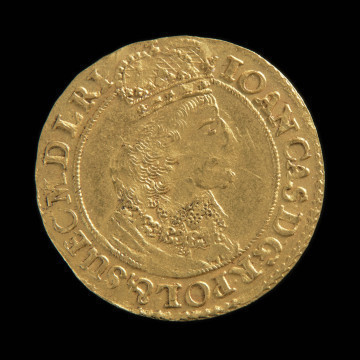
Ducat
1650
National Museum in Szczecin
Part of the collection: Polish coins
The 17th century was a period of exceptional prosperity in the history of Gdańsk. The city gathered wealth by trading in Polish grain and forest products. It also distributed luxury goods produced in the West and sought after by the Polish nobility. During the reign of Władysław IV Vasa (1595-1648), the rules of mint production introduced in the last years of the reign of Sigismund III Vasa (1566-1632) were still in force. The minting of petty coins was forbidden – it was limited only to the minting of more significant coins, namely thalers and ducats, in numerous denominations. Gdańsk became the main producer of gold coins in the Republic of Poland. Gdańsk ducats minted during the reign of Władysław IV do not differ in style from coins minted by previous Polish rulers. The obverse bears the royal effigy, and the rim had his key titles, corresponding with the place of minting of the coin and emphasizing the sovereignty of Wladysław IV over the Duchy of Prussia. This was the case even though in 1633 the ruler agreed that Prince George Wilhelm Hohenzollern (1595-1640) did not have to pay homage personally, but through his deputies. The detailed portrait of the king indicates that it was made by a skilful engraver, probably from the school of medal-maker Samuel Ammon (1590-1622). Particularly noteworthy are the elaborate crown and the details of the ruler's attire, albeit obliterated due to wear and tear of the seal. The reverse is also typical of city coins. It bears the coat of arms of Gdańsk with lions to its sides, and an inscription claiming that this gold coin was produced in the city of Gdańsk. The letters SB under the coat of arms are the initials of Stanisław (Stenzel) Berman, leaseholder of the Gdańsk mint. Berman is also known as an engraver of Gdańsk donation coins. The limitation of minting to the production of more valuable coins did not solve the issues of the Polish money market. The lack of native petty coins on the market opened the way for the outflow of more valuable coins, which was exchanged for foreign inferior money.
Mieszko Pawłowski
Other names
Dukat
Author / creator
Dimensions
cały obiekt:
Object type
ingot
Technique
minting
Material
gold
Creation time / dating
Creation / finding place
Owner
National Museum in Szczecin
Identification number
Location / status